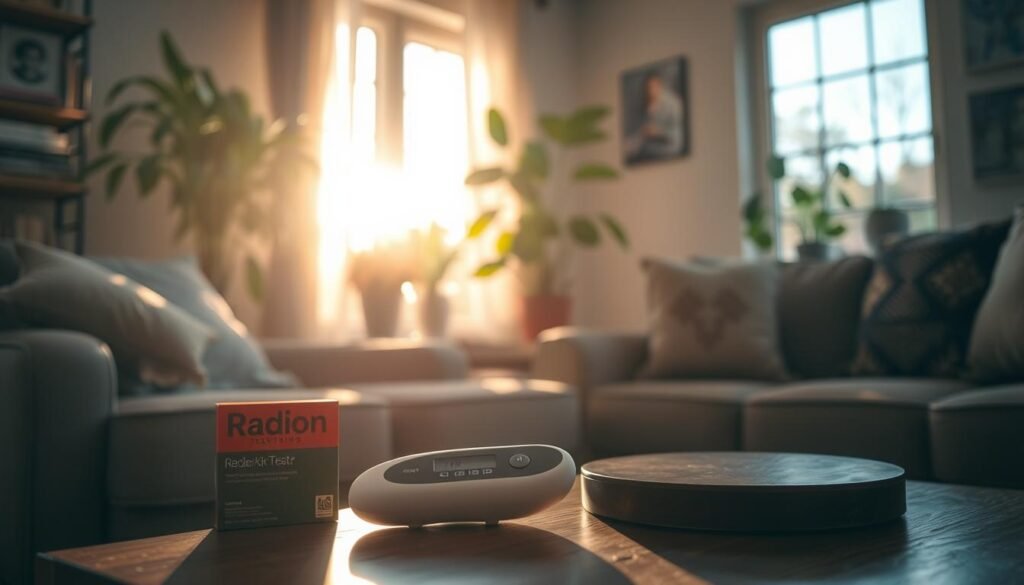Tobacco smoking is the main cause of lung cancer. It’s linked to almost 90% of cases in men and 80% in women. These numbers show how critical it is to grasp ways to cut lung cancer risks. Lung cancer is a top reason people die from cancer, with over 238,000 new cases in the U.S. in 2023. But, people can do things to greatly reduce their risk.
This piece will offer expert advice and proven ways to lead healthier lives and fight lung cancer. You’ll learn how to quit smoking and stay away from secondhand smoke. We’ll also explore environmental issues like radon. Understanding these dangers helps make choices that better lung health.
Key Takeaways
- Quitting smoking can significantly lower lung cancer risk and improve life expectancy.
- Testing homes for radon exposure is crucial for lung cancer prevention.
- Workplace exposure to carcinogens increases the likelihood of developing lung cancer.
- A diet rich in fruits and vegetables may help lower the risk, although it cannot fully counteract smoking risks.
- Regular exercise is associated with a reduced risk of lung cancer.
Understanding Lung Cancer Risk Factors
Knowing lung cancer risk factors is key to grasp the disease and find ways to prevent it. Smoking is a main cause, behind about 80% of lung cancer deaths. Small cell lung cancer is mostly seen in smokers, which is rare in non-smokers.
Secondhand smoke is also a big lung cancer cause in the U.S., making smoke-free areas important. Radon gas is another leading cause, especially dangerous for non-smokers. It is linked to 30% of lung cancer deaths in non-smokers, showing the need for awareness and measures.
Workplace hazards add to the risk. People exposed to asbestos, and who smoke, are at a higher death risk from lung cancer. Research also finds that heavy smokers taking beta-carotene supplements could up their lung cancer risk.
Family history matters in lung cancer risk. Your risk can double if your family has a history of lung cancer. This is especially true if two or more close relatives have had it. Even after surviving lung cancer, smokers can still get it again.
Being aware of these risks helps people make healthier choices. Knowing about lung cancer can lead to taking steps to prevent it, even though not all cases can be stopped. With the right knowledge, people can cut their risk based on their situation.
Quit Smoking
Quitting smoking is key for lung cancer prevention. It causes about 85 percent of lung cancer cases, leading to nearly 480,000 deaths a year in the U.S. Quitting can greatly lower death risk from cancers by as much as 40 percent. This shows how vital quitting is for better health at any age or smoking history.
The Importance of Quitting
Stopping smoking greatly reduces lung cancer risk and helps heal damaged lung tissue. If you quit by 40, you significantly cut your risk of dying from smoking-related diseases by 90 percent. Quitting by 54 still cuts your risk by two-thirds. Living with smokers can increase your lung cancer and heart disease risk by 30 percent due to secondhand smoke. So, quitting not only benefits the smoker but those around them too.
Quitting offers huge health perks. Quitting smoking makes everyone healthier.
Tips for Successful Smoking Cessation
Here are some effective ways to quit smoking:
- Identify personal triggers and avoid them.
- Consider using nicotine replacement therapies to ease withdrawal symptoms.
- Engage in behavioral therapy or support groups to stay motivated.
- Discuss the need for lung cancer screenings with a healthcare provider, particularly for heavy smokers.
- Utilize resources, such as hotlines provided by organizations like the American Cancer Society.
Former smokers have a lower cancer risk than current smokers, but still more than non-smokers. Stopping smoking can increase life expectancy by up to 10 years. This highlights the incredible benefits of quitting on overall health.
| Benefits of Quitting Smoking | Immediate Effects | Long-Term Health Improvements |
|---|---|---|
| Saving money | Improved taste and smell | Lower risk of lung cancer |
| Better breath | Enhanced physical endurance | Reduced risk of heart disease |
| No yellowing of teeth and nails | Healthier hair and clothing smell | Lower risk of other cancers |
Avoid Secondhand Smoke
Secondhand smoke is a big hazard to our lungs. It can lead to lung cancer and breathing illnesses. In the United States, secondhand smoke causes about 7,300 lung cancer cases every year. People around this smoke breathe in over 7,000 harmful chemicals.
Protecting yourself and others in places like homes and cars is important. It can greatly lower the risk from secondhand smoke. Doing this creates a safe environment for everyone, especially kids and pets. They’re more at risk from secondhand smoke’s harm. It’s key for families to push for smoke-free living areas to foster healthier lives.
It helps to talk openly about the dangers of tobacco smoke. You can explain health risks or talk about allergies and discomfort. These conversations might make smokers more considerate. Communities also help by setting up smoke-free zones. This makes everyone’s health better.
Testing for Radon
Radon gas is a big health risk. It can make lung cancer risk go up, especially in homes. It’s important to know about radon to keep homes safe. Testing for radon can find dangerous levels. It gives homeowners peace of mind.
Why Radon is a Risk Factor
Radon is a radioactive gas from the earth. It can build up in homes, especially below ground. It’s a top cause of lung cancer for people who don’t smoke. And it’s second for those who do. The EPA says about 21,000 people die each year from radon in the U.S. This fact shows why testing for radon is crucial.
The normal radon level in American homes is around 1.3 pCi/L. But levels above 4 pCi/L make lung cancer risk much higher. The EPA says to act if radon levels are between 2 pCi/L and 4 pCi/L. They suggest getting help from a pro if levels hit 4 pCi/L or more.
Steps to Conduct a Radon Test
It’s easy and important to test your home for radon. Here’s how to do a radon test:
- Buy a radon test kit from a hardware store or online for about $20.
- Put the detector on the lowest floor, as the kit directions say.
- Leave the detector there for the test time, which can be 2 to 90 days.
- Afterward, send the results to a lab to find out what they are.
- If radon levels are over 4 pCi/L, you need to act fast to lower them.
Everyone should try to have the lowest radon level in their home. This reduces the risk of lung cancer.

Occupational Hazards and Lung Cancer
Lung cancer is a big risk in many jobs due to exposure to cancer-causing agents. About 41% of Americans will face cancer in their lifetime. This fact highlights the need to be aware of lung cancer risks at work. Jobs in mining, construction, and manufacturing can be more risky. They often expose people to harmful substances that raise lung cancer rates.
Some of the biggest worries are occupational hazards like diesel exhaust and silica dust. Even a little exposure to diesel can increase lung cancer risk. In the U.S., about 1 million workers face this danger. The numbers are even higher in Europe and Asia. Also, nearly 2 million workers in America are exposed to silica. This exposure can make someone more likely to get lung cancer, even if they don’t smoke.
To fight these risks, protective steps are very important. Employers must set up strict health and safety rules. They should make sure workers know how to stay safe and use personal protective equipment (PPE). Following these guidelines means less contact with dangerous substances. Taking action to keep the workplace safe also helps lower health risks from work-related carcinogens.
Statistics show that a big chunk of cancers worldwide come from toxic exposures at work, estimated at 7% to 19%. Lowering these exposures can lead to fewer cases of certain cancers. This shows that we can make workplaces safer. Knowing about lung cancer risks at work is key to protecting workers from this serious illness.
Maintaining a Healthy Diet
A balanced diet is vital in cutting lung cancer risk. It boosts overall health by adding foods that fight lung cancer. Eating right plays a big role in preventing health problems.
Focusing on fruits and vegetables improves wellness. It also strengthens our defense against chronic diseases.
Foods that May Lower Risk
Adding diverse foods to a cancer-fighting diet helps a lot. Some foods, full of antioxidants and phytochemicals, might cut lung cancer risk:
- Cruciferous vegetables like broccoli and kale
- Fruits high in vitamin C, such as oranges and strawberries
- Whole grains, which provide fiber and nutrients
- Berries, including blueberries and raspberries
- Legumes, which offer protein and antioxidants
Importance of Fruits and Vegetables
Fruits and vegetables are key for good health. They have vital vitamins, minerals, and fiber that aids digestion. Eating a variety of these can boost nutrition and may help lower lung cancer risk.
Dietary antioxidants in these foods may protect cells. This helps prevent damage that can lead to cancer.

Fruits and veggies are crucial for cancer prevention. They can’t substitute for a healthy lifestyle or avoiding bad substances. But, they help the body stay strong and healthy.
For the best nutrition against cancer, talk to a registered dietitian nutritionist. They can strengthen your dietary fight against cancer.
Exercise Regularly
Regular exercise is key in physical activity lung cancer prevention. Studies show active people enjoy many health benefits. They have a lower risk of lung and other cancers. It also helps control weight, which can lower cancer deaths. In the U.S., overweight issues contribute to 14%-20% of these deaths.
The American Institute for Cancer Research suggests adults do 150 minutes of moderate or 75 minutes of high-intensity exercise weekly. Options like brisk walking, dancing, or yardwork count as moderate exercise. More intense activities include jogging and swimming. Kids should exercise for an hour daily, doing vigorous activities three times a week.
But, too much sitting can be harmful, even with regular exercise. It increases obesity and cancer risks. It’s good to move more throughout the day. Adults should aim for 30 minutes of moderate exercise five days a week. This promotes a healthier lifestyle.
A variety of exercises boosts lung health. This includes aerobic activities and strength training, like weight lifting or Pilates. Exercise benefits everyone, regardless of age or health status. Still, check with a doctor before starting or changing an exercise plan, especially if you have health issues.
In high pollution, choose indoor exercises. An active life reduces the risk of many diseases like diabetes and heart disease. Physical activity offers immediate and long-term health benefits. It’s a strong foundation for preventing cancer.
| Activity Type | Intensity Level | Recommended Duration |
|---|---|---|
| Brisk Walking | Moderate | 150 minutes/week |
| Jogging | Vigorous | 75 minutes/week |
| Dancing | Moderate | 150 minutes/week |
| Swimming | Vigorous | 75 minutes/week |
| Weight Lifting | Strength Training | Twice a week |
Air Pollution and Its Impact
Air pollution greatly impacts lung cancer risk. Studies show a clear link between poor air quality and a higher chance of cancer. Over the past 40 years, research suggests air pollution, mainly from burning fossil fuels, could raise lung cancer rates. People around harmful chemicals and particles, from cars or factories, face serious health risks.
Recent studies found a 30 to 50% jump in lung cancer rates from breathing in fine particles. Even with better laws, many in the U.S. still breathe in harmful pollutants. These include known or suspected cancer-causing agents, sparking pollution and health worries.
The role of air pollution in U.S. lung cancer cases might be bigger than we think. We need better studies for clearer risk figures from air pollution. Right now, data lists gasoline exhaust as a possible cause of cancer, says the International Agency for Research on Cancer (IARC). Diesel exhaust, radon, and polluted outdoor air are confirmed as cancer causes.
Since outdoor pollution boosts lung cancer risk, it’s vital for people and policymakers to push for cleaner air. Less pollution means better lung cancer air quality for all. For more info, check lung cancer and pollution for deeper insights on this important topic.
| Type of Pollutant | Associations with Cancer |
|---|---|
| Particulate Matter | Known carcinogen linked to lung cancer |
| Diesel Engine Exhaust | Known carcinogen associated with increased lung cancer rates |
| Gasoline Engine Exhaust | Possible carcinogen, requires further study |
| Volatile Organic Compounds (VOCs) | Certain types are known carcinogens |
| Polycyclic Aromatic Hydrocarbons (PAHs) | Known carcinogens linked to various cancers |
Family History and Lung Cancer Risk
There’s a strong link between family history and lung cancer risk. Studies show that if a close family member had lung cancer, your risk increases 1.51 times. This risk is even higher if a brother or sister had it, jumping to 1.82 times. It shows how genetics and cancer risk are important in figuring out who might get lung cancer.
It’s not just about immediate family members. If your dad had lung cancer, your risk goes up by 1.41. But if it was your mom, your risk increases to 2.14. Also, having a family member with chronic bronchitis raises your lung cancer risk to 1.49. This tells us why keeping track of family health history is key.
For people who’ve never smoked, the link between family cancer history and their own risk is still significant but less strong. They have a lower odds ratio of 1.25. This points to genetics playing a role in lung cancer risk, separate from smoking. Knowing your family’s cancer history could help you get ahead with monitoring and prevention through genetic counseling.
Other factors like harmful materials and pollution can also affect lung cancer risk. Knowing your family history helps doctors give better advice on screenings and how to live healthier. Find out more about family history and lung cancer here.
| Relative Type | Odds Ratio (OR) |
|---|---|
| Mother | 2.14 |
| Father | 1.41 |
| Sibling | 1.82 |
| Chronic Bronchitis History | 1.49 |
| Pneumonia History | 0.73 |
Ways to Reduce Risk of Lung Cancer
Lung cancer is the second most common cancer in the United States. There are ways to lower your risk of lung cancer. Knowing these tips can help you make healthy choices.
Summarizing Essential Prevention Strategies
Quitting smoking is a key step. It brings immediate health benefits. Stopping smoking can greatly cut lung cancer risk. About 90% of lung cancer cases are due to smoking.
Radon exposure is the next leading cause. Testing your home for radon can show if there’s a risk. Learn more about radon and cancer prevention at this page.
Living a healthy life is also important. Exercise often and eat a diet with lots of fruits and veggies. Avoiding work hazards and air pollution helps too.
Yearly screenings are vital for those at high risk. This includes heavy smokers and people aged 55 to 80. Low-dose CT scans can save lives compared to X-rays.

Using these prevention tips can lower your lung cancer risk. Implementing these strategies can improve your lung health significantly.
Conclusion
Reducing lung cancer risk is a team effort. It combines many healthy lifestyle choices. Quitting smoking and steering clear of secondhand smoke can lower lung cancer risks a lot. It’s also key to watch out for things like radon and air pollution, which play a big part in lung cancer.
Eating well and exercising regularly are also great ways to stay healthy. They help protect against lung cancer. Though lung cancer is still a top cause of cancer deaths, sticking to these prevention tips improves survival rates. It shows the value of being proactive about lung cancer prevention.
Knowing how to cut cancer risk gives people power to make smart choices. Every step toward healthier living adds up, benefiting not just you but also those around you. By spreading the word and staying motivated, we all can look forward to a future with less lung cancer.